-
Morning at a North Country Bakery: Behind the Scenes

The Polish Princess Bakery opens for business, but in the hours leading up to that…. Last Sunday morning, at 3:30am, I dragged myself out of bed, hastily threw on whatever random items of clothing I could find, half-consciously gulped down a cup of tea and drove 10 minutes to the Polish Princess Bakery in Lancaster, New Hampshire. 3:30am? The only reason I’m ever awake at 3:30am is insomnia. What could possibly motivate me?
Well, I’ve been an amateur baker for many years. And for some time, I’ve wanted to learn first-hand about the inner workings of a commercial bakery. I’m especially interested in the early morning schedule for baking breads and pastries and how to coordinate mixing, rising, shaping, decorating, proofing and baking. The best way to learn? Spend a morning at the Polish Princess. In early 2014, Magdalena Randall opened this remarkable bakery and cafe on Main Street in Lancaster. For several years prior to opening, she’d already built a reputation and following as an accomplished baker, first selling out of her home, and then at the weekly farmers’ market.
I’ve been a regular customer since the bakery opened, but now was the time, I decided, to learn the workings of the “back of the house.” Magda graciously let me come to observe, ask questions, and even help out a little with the shaping of the loaves. Throughout the morning, Magda answered my questions about baking, but also shared amusing, fascinating, and sometimes heartrending stories about her struggles as a small business owner and entrepreneur.
Magda and one employee, Lorien, arrived-as they do all mornings–at 4:00am sharp. The first two tasks were to turn on the propane steam oven (since it takes at least 90 minutes to warm up), and then to take the temperature of the poolish sitting in the industrial-size mixing stand. The poolish is a pre-ferment leavening agent, a mix of water, flour and yeast which sits for at least 12 hours, overnight. Temperature matters a lot for serious bakers. In fact, I lost count of how many times I saw Magda look at the bakery thermometer or take the temperature of the poolish or the water. The overall temperature in the bakery governs all of the other steps involved in bread baking, such as the level of hydration in the overall dough and the rising and baking times.
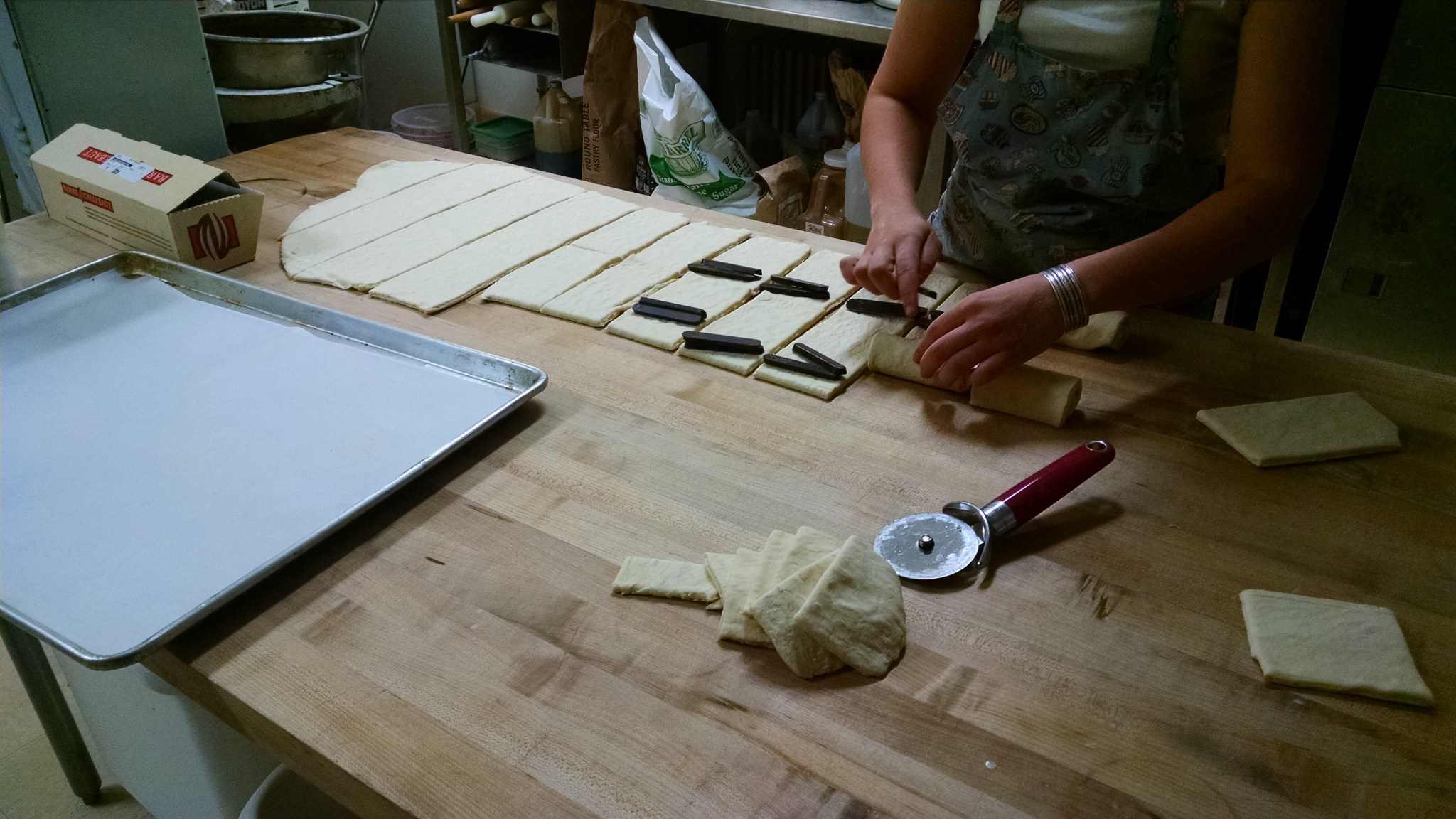
The rolling out of chocolate croissants, 4:30am. Next step was to mix the poolish (pre-ferment) with the remaining flour and water (but not salt or yeast, yet) for the “autolyse,” a period of about 20-30 minutes in which the dough simply sits at rest. Meanwhile, Magda pulled out a huge box of apples and started cutting and peeling by hand–I’ve never seen anyone prep apples so fast as she did that morning. Across the room, her employee, using a table rolling machine, flattened out a huge chunk of croissant dough, and began cutting and rolling it into shape. The croissant dough had been “laminated,” a time-consuming process of folding and refolding the pastry into layers around a butter block, the previous day, and then refrigerated. Plain, almond and chocolate croissants are all daily staples of this particular bakery, and I watched in amazement as the ingredients were deftly, and at lightning speed, inserted into the layers of pastry, then stored in a proofing machine (for rising).
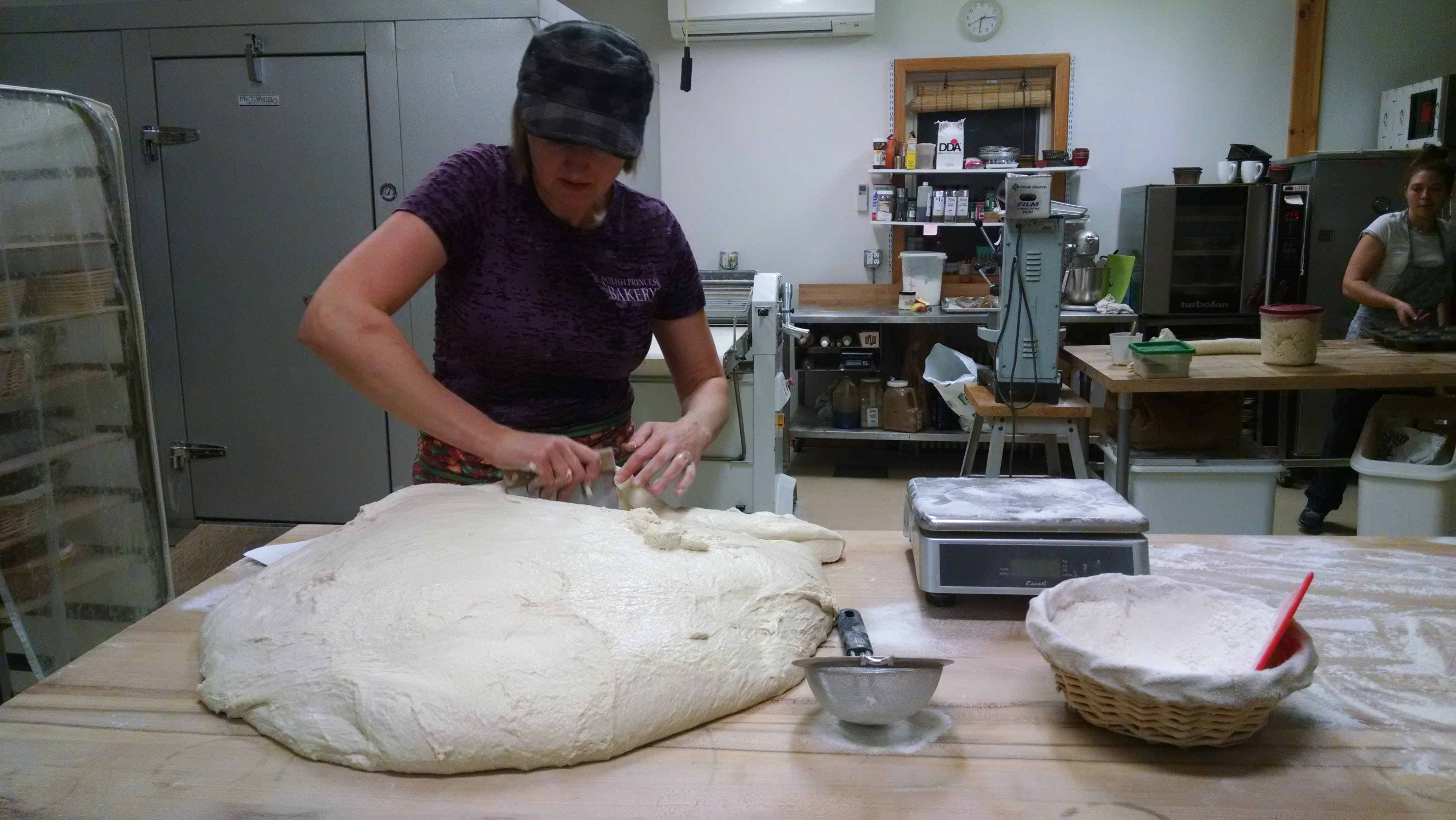
Magdalena dividing the french bread dough, with employee in the background working on pastries, approximately 5:45am. Morning production at the bakery is a complex dance in which the bakers must coordinate rolling out, proofing, inserting filling or toppings, second risings, then baking and cooling. Once the croissants were done, Magda’s employee set to work on lemon curd and apple tarts, blackberry muffins, orange/cranberry scones, cinnamon buns, and cookies. Meanwhile, Magda checked her orders from the previous day, which included an order for 4 pies (two apple and two cherry) and 2 quiches (broccoli and olive). She keeps a giant mix of quiche filling in the big refrigerator, and once the pie shells are rolled out and the veggies cut up, the filling gets poured in.
There are two ovens at the bakery, the huge propane, steam oven for the breads and bagels, and then the smaller oven for pastries. Magda kept a close eye on the pastry oven to make sure it was turned off as needed when not in use. Her electric bill at the bakery, she told me, is higher than her rent, and the small oven and the cappuccino/espresso machine are the big electricity drains.
By now, the french bread dough has gone through autolyse, two mixings on different speeds, and has to rise for about two hours. And of course, those two hours are full of other work, like the bagels and the assortment of pastries. When the dough is risen to her satisfaction, Magda hauls the massive hunk onto the cutting board table, where she uses a hand dough scraper to cut it into chunks for loaves and baguettes. She works quickly and efficiently, using a scale to make sure each chunk is the right size for the type of loaf. And she reserves one sizable chunk as pizza dough, in case anyone orders a pizza for lunch. (Edward and I have often done this!)
The poolish-fed dough is central to the morning’s production, but it’s not the only bread in the works. Sitting inside a plastic covered rack are lovely round loaves in baskets and longer loaves hidden in the folds of linen. These are various sourdough loaves mixed the previous day and proofed overnight. And of course, the beautiful bagels, which as far as I can taste and tell, rival any from New York.

Baguettes, scored before baking Now, she starts baking the sourdough loaves, and while they bake, she starts shaping the french bread into baguettes and loaves. I’m watching closely, because I want to remember how she does this, and she has me help her shape and roll out the baguettes, in very precise fashion indeed. After this, they are placed, seam side up, into the folds of bakers’ linen, for a final rising.
I’m envious of Magda’s big steam oven. All she has to do for that lovely steam is to push a button. At home, I usually have to throw ice cubes into a pan on the oven floor 5 minutes before baking, and then a cup of boiling water is poured into a hot pan in the oven right before the loaves go in. It’s tricky to get it right, and avoid being burned by the steam.
After the final rising of the baguettes and french loaves, Magda scores them with a razor held at a 30 degree angle and they go into the oven for around 24-26 minutes, but the time really depends on how they look to Magda, and what she knows about the temperature in the bakery and the rising periods leading up to the baking. It seems complicated to me, but Magda has developed an instinctive sense for how the dough looks and feels as it goes through its many stages.

First customers of the morning, approximately 7:05am. They were looking for a full sit-down breakfast, which we did not have. At about 6:30am, a second employee arrives, and begins to set up the front of the house. Pastries have been steadily coming out of the smaller oven–croissants, muffins, tarts, scones, the pies on order, a coffee cake. Those pastries cool in tall, plastic-covered racks and now are moved into the glass case on the counter, looking tempting and glorious. The pace in the room becomes a little feverish, in anticipation of opening at 7am. The pastries will be ready by then, although most of the bread isn’t ready until about 8am. Magda has been preoccupied with the dough and the ovens until now, but at this stage, she has to stand on the customer counter to repair a light. Someone rolls up the blinds. There’s a brief discussion about the choice of music for the morning.
By 8:00am, the baguettes and virtually all the bread are stacked on a tall cart and rolled close to the counter, where customers can eyeball the loaves and decide which ones they want. Soon enough, there’s a steady stream of customers, and before long, it will be time to prep the soups and sandwiches for lunch.
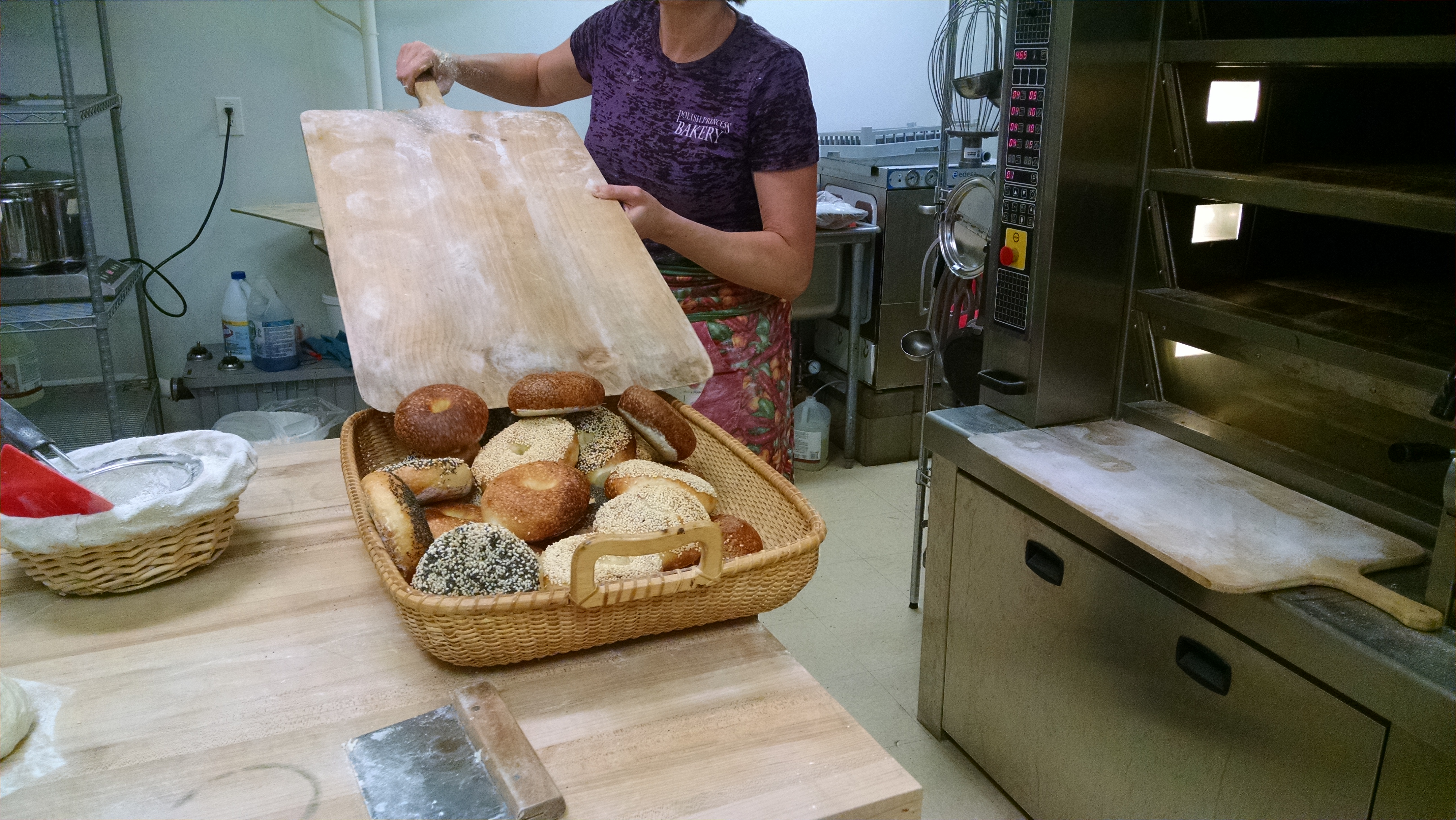 I leave at about 8:15am, tired but happy. Four magical hours at the Polish Princess, and I’ve got a new outlook on baking, with some important new tips and tricks. I’ve been over to the bakery as a customer twice since that early morning adventure and now, of course, I see the Polish Princess in a wholly different light…
I leave at about 8:15am, tired but happy. Four magical hours at the Polish Princess, and I’ve got a new outlook on baking, with some important new tips and tricks. I’ve been over to the bakery as a customer twice since that early morning adventure and now, of course, I see the Polish Princess in a wholly different light… -
Land Records and Glebe Lots: My House History Hunt

The vault and land records at the Lunenburg, Vermont Town Office My recent blog post about the Class 4 road that runs by our camp in the hills elicited an intriguing comment from my neighbor and long-time town resident Amos Bell. He told me that his maternal grandmother, Sadie Hagan Powell, had lived at the “Hagan Place,” (meaning our place), and taught school at the little schoolhouse across the road. It was once a school, apparently, now it’s a tiny little camp under private ownership.
An email inquiry of the house’s most recent owners before us–who now live in Chittenden County–didn’t really clarify things, so one day this week, I went down to the town office to spend an hour or so combing through the land records to see what I could learn about whether Sadie Hagan’s family had indeed owned our house.
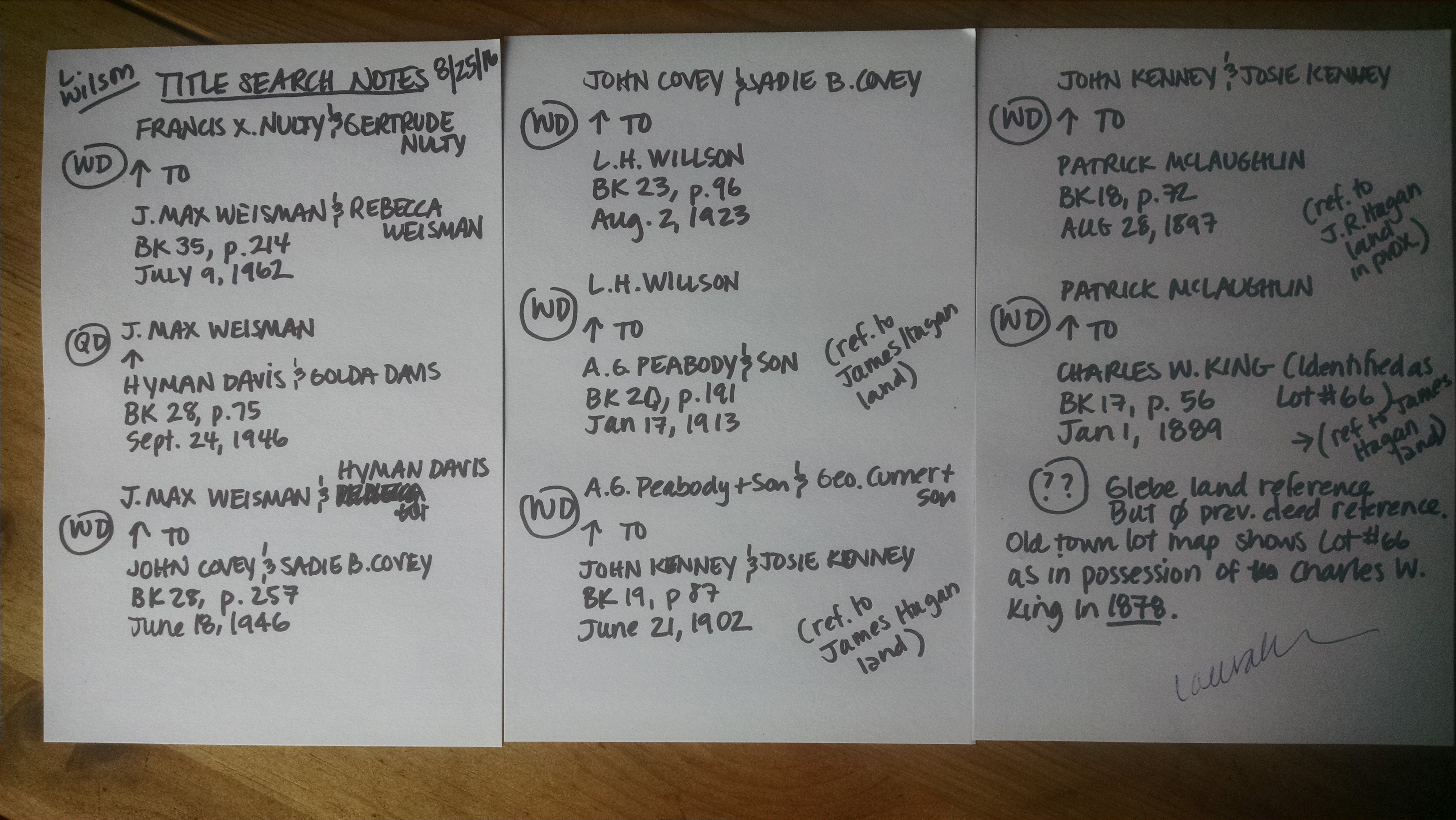 Here are my title search notes from that examination. I’m an attorney who practices mostly criminal defense and other litigated matters, not transactional law. However, my senior law partners are experienced real estate lawyers, and they have trained me enough so that I’m competent in handling basic real estate transactions, including title searches, which I do professionally from time to time. These are a rough approximation of the kinds of notes I would take for a professional title search on behalf of a client seeking to buy a property, which would then typically be referenced in a formal document called a “title opinion.”
Here are my title search notes from that examination. I’m an attorney who practices mostly criminal defense and other litigated matters, not transactional law. However, my senior law partners are experienced real estate lawyers, and they have trained me enough so that I’m competent in handling basic real estate transactions, including title searches, which I do professionally from time to time. These are a rough approximation of the kinds of notes I would take for a professional title search on behalf of a client seeking to buy a property, which would then typically be referenced in a formal document called a “title opinion.”Vermont title standards only mandate that the attorney do a 40 year backward search to establish marketable title, but today, I went much further than that, because my goal was history, not marketable title. (And of course, no need for the title opinion here!)
As the notes show, I didn’t start with the present day. That’s because I know who owns the house now, and I know for sure who owned it previous to us. I started instead in 1962, the date that the parents of our friends (former owners) acquired the house. (The story of how Francis and Gertrude Nulty, of Somerset, New Jersey, came to visit, and then purchase this farm in the most remote reaches of northern Vermont is a fascinating story in its own right, for another day).
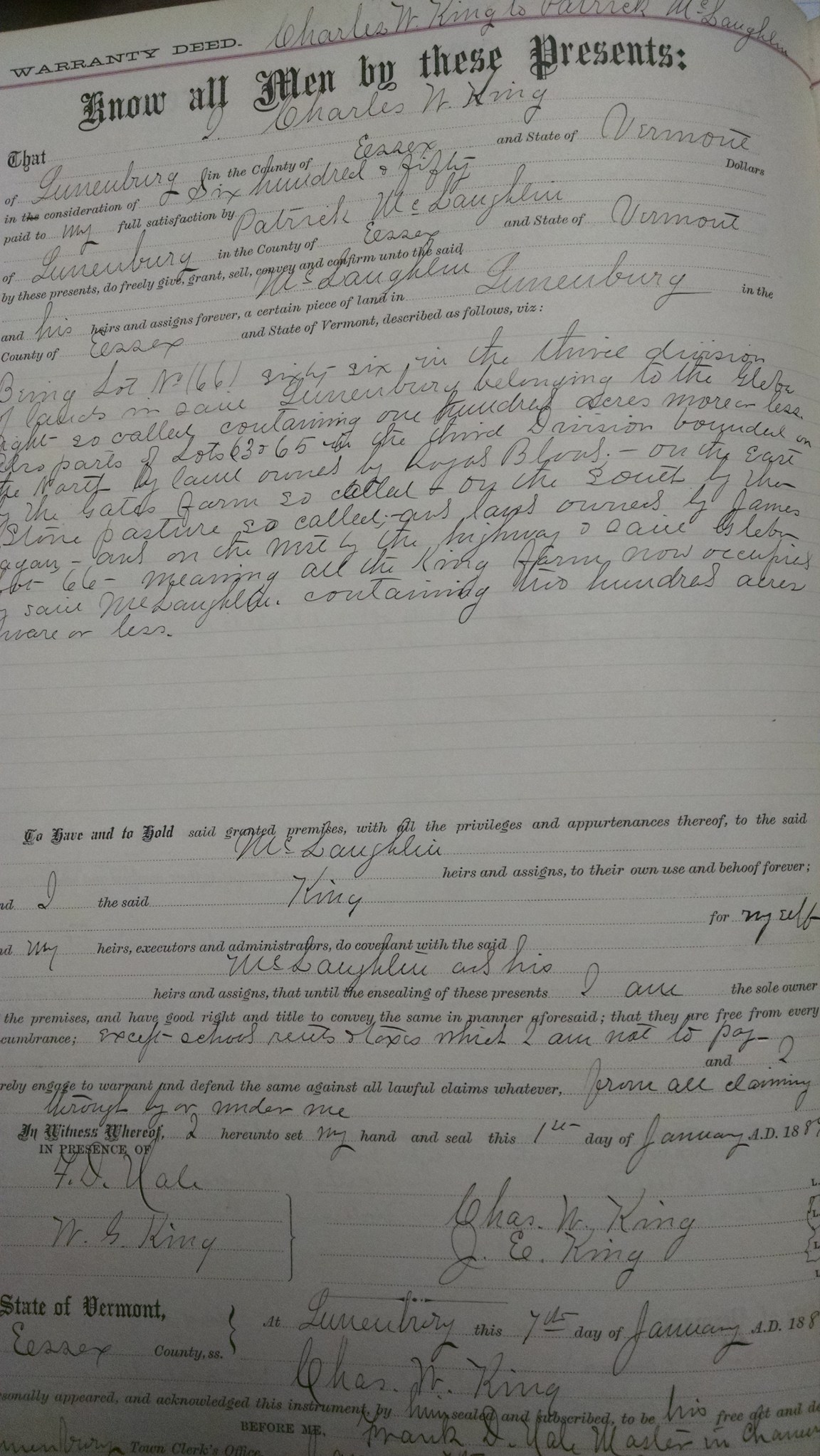
Working back from 1962, I reached something of a dead, or at least dormant, end with the deed in which Charles W. King sold the property to one Patrick McLaughlin, in 1889. In almost all deeds, I expect to see a property description which includes a clear reference to the previous deed through which the seller acquired the property, including the date the seller acquired it, and the book and page number where that deed is recorded in the land records. These references are the keys to tracing chain of title. But in the 1889 King to McLaughlin deed, that information just isn’t there. Instead, the deed simply makes reference to it being derived from Lot 66, of “Glebe-right land.”
Ah hah! This perked my interest and curiosity immediately, because Glebe lands, also known simply as “leased lands” are a unique (and largely arcane) Vermont institution, involving lands that generate revenue for school districts by being leased rather than actually owned. Here might be an important piece of the puzzle, since I’d already gotten a clue from my neighbor that land in close proximity to ours belonged to a school back in the day.
“Glebe” is defined by Merriam-Webster dictionary as land belonging to or yielding revenue for a parish or other ecclesiastical benefice.” During the pre-revolutionary era, the governors of New York and New Hampshire, acting on the authority of the English Crown, made numerous land grants all over Vermont, designed to generate revenue for the Church of England and for their schools. That doesn’t necessarily mean that all such glebe lots had schools or churches on them, although some did. The operative, defining feature of the Glebe lots was that they were used to generate income for the churches or their schools. Hence, the person who occupied a Glebe lot was not the owner, but rather a leaseholder, and paid annual rents to the church or school, in lieu of property taxes. The Glebe lot leases usually contained language entitling the leaseholder to the use of the property “so long as grass grows and water runs,” or similar “language of durability.”
After the American Revolution, ownership of the Glebe lands–and their revenue–passed to the municipalities, who collected the annual rents and turned them over to school districts. In 1947, the Vermont legislature passed a statute which allowed municipalities to sell glebe lands, as long as the proceeds went to the school district in town. I first became familiar with the Glebe lots when I was Town Clerk in my little Town of Guildhall since they crop up periodically in the land records of virtually all Vermont towns. Our town has several Glebe lots, but no one seems to be collecting any revenue on them any longer, their boundaries are unclear and confusing, and I rather doubt that many municipalities are even following the statutes relating to Glebe lots properly. They just don’t matter much anymore. Another example of a Glebe lot in Guildhall is the lot on Guildhall Hill where the old church monument sits. I wrote a piece on this blog about the monument last year, which you can read here, if you care to. At some point in the 1890s, that particular church, which no longer even had a building on that location, decided to lease the Guildhall Hill glebe lot to the Town of Guildhall, for free, and “as long as trees grow and water runs,” the telltale Glebe lot language of durability.
Although Glebe lands are largely arcane and most towns don’t even keep track of them in any systemic way any longer, they still occasionally crop up as mini-obstacles in real estate transactions. Read about this interesting little recent dust-up in the city of Burlington, from the newsweekly Seven Days, about when a family tried to sell their downtown condo. A zealous buyer’s attorney for some reason discovered that the property may technically have been a glebe lot. The buyer considered it a title defect, and so the sellers asked the city to figure out the status and if necessary, execute a quit claim deed to the sellers so that the title “defect” could be resolved to the buyer’s satisfaction. (In the end, it was resolved by the City of Burlington executing a Quit Claim deed to the owner/sellers, for the nominal sum of $50.00)
It’s not altogether clear in the case of our house whether the land was actually glebe land, or whether it was carved out of previous Glebe lots and conveyed as a conventional deed. The language in the deed itself is ambiguous and other documents don’t shed much light on it. Being able to review a previous deed or lease that granted use or ownership of the property to Mr. Charles King would help, but finding that document, if it exists, would take a lot more time.
 By looking at an old lot map of the Town, I was at least able to push the date back a little further. The map shows that in 1878, eleven years earlier, Charles King was still the owner. That helps a bit. Armed with that knowledge, however, I would still have to work backwards, going painstakingly through the index of each land record volume. This is time-consuming. Starting around roughly the 1890s-1900, all land transactions at the Town Clerk’s office are recorded in a centralized and cross-referenced card catalog, which expedites searching. But before that, each book has its own index, so you’d have to review each index in each book, name by name. Some day maybe I’ll get to it.
By looking at an old lot map of the Town, I was at least able to push the date back a little further. The map shows that in 1878, eleven years earlier, Charles King was still the owner. That helps a bit. Armed with that knowledge, however, I would still have to work backwards, going painstakingly through the index of each land record volume. This is time-consuming. Starting around roughly the 1890s-1900, all land transactions at the Town Clerk’s office are recorded in a centralized and cross-referenced card catalog, which expedites searching. But before that, each book has its own index, so you’d have to review each index in each book, name by name. Some day maybe I’ll get to it.As for Sadie Hagan? Well, she and her family’s residence are still a mystery. My title search from now back to Mr. Charles King indicates that between 1878 and now, no Hagan ever owned this property. However, in the oldest four deeds, those dated 1889, 1897, 1902, and 1913, there is a reference in the property description that reads “…and bounded on the south by lands of James Hagan…” But why then, does the card catalog index, which seems to be reasonably accurate, at least in 1913, show absolutely no property for any Hagan at all anywhere in the Town? Is this a gap in the card catalog records? (Not unheard of in old New England land records). Or might it mean that the “lands of James Hagan” alluded to in the deeds’ property descriptions were not actually owned by him, but were themselves Glebe lands, and the Hagans were leaseholders, not owners? I have a feeling this one is going to remain a mystery. When and if I find the time to spend hours poring over the indexes in each land record volume, going backward from 1878, I could conceivably find that a Hagan actually owned our property. But until then….
-
A Blackberry and Apple Vacation
 I love August vacations in Vermont, in part because I can bake using my favorite in-season fruits. This time of year, the meadows, thickets, and byways of northern Vermont are bursting with a profusion of blackberries and apples.
I love August vacations in Vermont, in part because I can bake using my favorite in-season fruits. This time of year, the meadows, thickets, and byways of northern Vermont are bursting with a profusion of blackberries and apples.Down in the meadow below our camp, one of us picks blackberries just about every morning. When we walk up and around highway #46, we can stop at just about any spot on the road and grab handfuls of blackberries to eat. Even our dogs like them. It dates back to my childhood somehow–there is something magical about picking blackberries in August, with the buzz of crickets in the air and the fading light.
Apples are equally abundant now, too. On my morning run up Pond Hill Road this morning, I identified at least 5 different varieties of apples, hanging low and heavy from roadside trees.
Here are some of the things I’ve baked or intend to bake so far on this staycation:
Blackberry Muffins. (See photo above. I think these are the best muffins I’ve ever made!)
Blackberry Almond Tart with a Cornmeal Crust. The cornmeal crust is my favorite variation on the crust. You just have to substitute half a cup of corn meal for flour. It gives the pie or tart a great rustic flavor and works well with both apple and blackberry.
Blackberry Scones.
Blackberry Apple Pie. Blackberries and apples are uniquely suited to one another, with their combination of tartness and sweetness, especially in pastry. Several years ago, when I entered the pie-making contest at the Lancaster Fair, first prize went to an extraordinary apple-blackberry pie. I’ve also added apples to the blackberry muffin recipe, above, and it works beautifully.
Apple Galettes. It took me a while to get the hang of the galette pastry. Many thanks to Magdalena Randall, of the Polish Princess Bakery in Lancaster, New Hampshire, who gave me one or two simple but incredibly important and effective tips for delicious galettes. (I have also made rhubarb and pear galettes, but I think the apple ones are the best).
Apple Pie with a Cheddar Cheese Crust. Several years ago, I entered this pie into the contest at the Lancaster Fair, and I won second-prize!
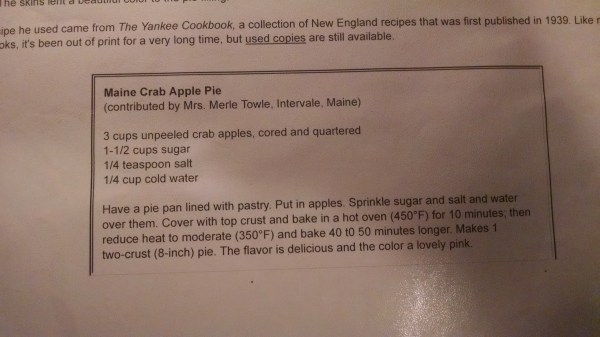 Crab Apple Pie. This is my favorite apple pie, although crab apples, at first blush, are not very glamorous or interesting in appearance. I discovered their potential for pastry by accident a few years ago, when I was walking in the woods up on Courthouse Hill near my house in Guildhall, and encountered a bunch of fallen crab apples. On impulse, I gathered up a bunch, took them home, and made a pie using this recipe.
Crab Apple Pie. This is my favorite apple pie, although crab apples, at first blush, are not very glamorous or interesting in appearance. I discovered their potential for pastry by accident a few years ago, when I was walking in the woods up on Courthouse Hill near my house in Guildhall, and encountered a bunch of fallen crab apples. On impulse, I gathered up a bunch, took them home, and made a pie using this recipe. -
A Pleasant, but Elusive Road in Vermont
This is Hagan Road, also known as town highway #46. It’s a dirt and rock hardscrabble road near our camp in the hills of Essex County. For decades, Edward and I and various friends and family members have walked this road, which ascends a steep hill and after another mile or so, makes a sharp right, and then takes
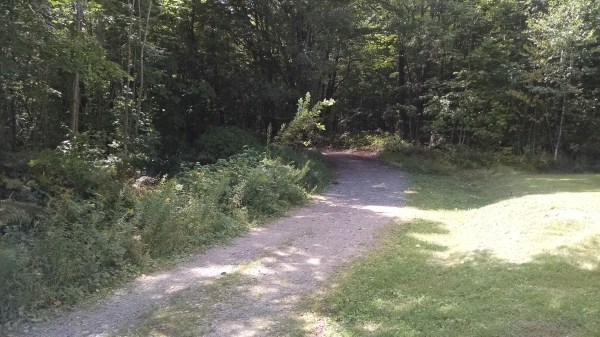 you on a pleasant, five mile loop back to the road “proper.”
you on a pleasant, five mile loop back to the road “proper.”There’s a town highway map–as there are online, for all Vermont municipalities–and our town’s shows Hagan Road as ending mysteriously after .47 miles, petering out into the white space of the map. But we know all too well that the road continues, and that it’s a real, albeit rough road, and not just a trail. That’s because all too regularly, we see it traversed by pickups, logging trucks, four-wheeler ATVs, bicycles, horseback riders and even the occasional moped, as just zipped by as I sit here typing this blog post. Moreover, there are at least half a dozen camps on that phantom 5 mile stretch of road, and camp owners use motor vehicles for access.
This is a Class 4 road. That means the Selectboard of the Town can use its judgment to decide whether or not “necessity, the public good, or convenience of town inhabitants” warrant regular maintenance. 19 V.S.A. 302. This Town has decided not to maintain this road over the years, no doubt because there is not a single full-time residence anywhere on the road, real or phantom–and this little Essex County town isn’t exactly flush with money to be keeping up little-used roads.
Prior to 1974, Vermont roads were either roads or trails, period. But that year, the Vermont legislature decided that Selectboards of municipalities had to classify all Town roads. Since then, that system of classification determines what the Town’s statutory maintenance obligations are, for any given roads. (As an aside, I became interested in the ways and history of Vermont roads when I served as the Guildhall Town Clerk and Treasurer, from 2006-2012.)
The classification system is simple, as follows:
State Highways: maintained exclusively by the State of Vermont;
Class #1: town highways that are extensions of existing state highways. Must be maintained; Class #2: those Town highways deemed “as most important to the Town”, with that decision made by the Selectboard in consultation with VTrans; Class #3: All traveled town highways other than Class 1 and 2; Class #4: Maintained only to the extent required by necessity, the public good, and the convenience of Town inhabitants. Also part of the classification system are legal trails, for which the Town has no statutory obligation to maintain, and ancient roads. (Read more about ancient roads in Vermont, in a recent New Yorker magazine article).
In general, class 1, 2, and 3 roads must be kept in “good and sufficient repair during all seasons of the year, although Selectboards can elect not to plow Class 2 and 3 roads if there are “safety considerations for the traveling public and municipal employees.”
And although Towns are not generally required to maintain Class #4s like Hagan Road, the Vermont League of Cities and Towns has interpreted Vermont case law to mean that Selectboards are required to keep bridges and culverts on those roads in good repair. That answers a recent question that occurred to me as we walked our 5 mile route and I saw repeated examples of newly repaired, shiny culverts, which seem oddly out of place in this wilderness.
-
Stone Garden Circle
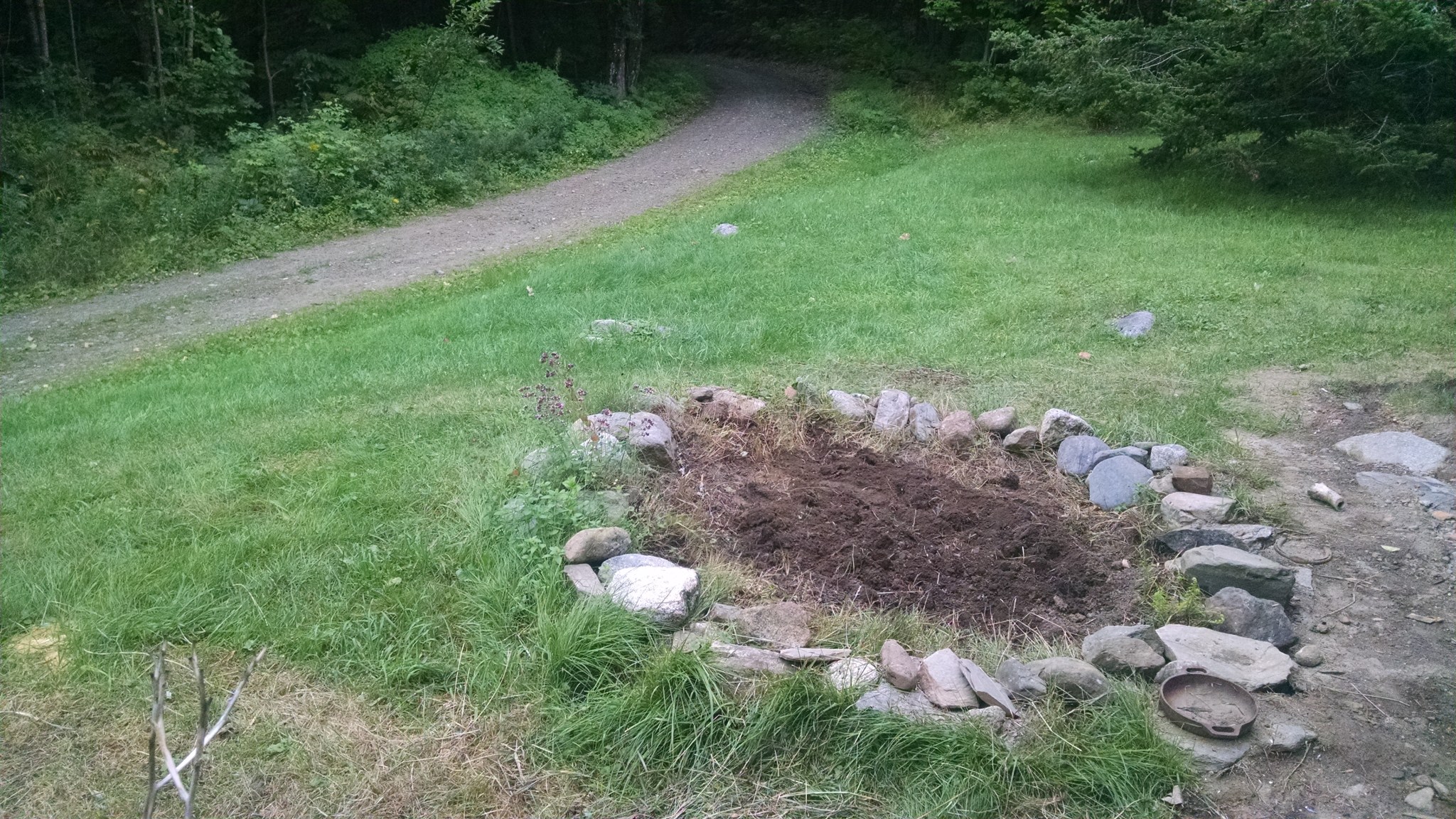 Yesterday I cleared out the overgrowth and rebuilt this stone circle up at our camp. I built it about five years ago as a place to grow herbs. It became a bit neglected, with tall grass and invasive oregano choking it almost out of sight.
Yesterday I cleared out the overgrowth and rebuilt this stone circle up at our camp. I built it about five years ago as a place to grow herbs. It became a bit neglected, with tall grass and invasive oregano choking it almost out of sight.I pulled up all the grass, weeds, and most of the oregano (I left a small patch, to the lower left.) And I rebuilt the stones into more of a respectable circle. Then I used a pitchfork and rake to loosen the soil.
I have not decided how to use it this time around. I could replant perennial herbs. But I am also thinking of using it for some cool weather crops. If I plant lettuce, arugala, radishes, spinach, and peas now, they could be harvested for dinners, when we come up here in October and even November.
And if we take the extra step of placing one or two layers of plastic over it, we could even have salad greens into the winter itself. I looked up plastic greenhouse domes for sale. They exist, but that might be an unnecessarily complicated step.
I will mull it over and I sit on the porch staring randomly off into space.
-
Elvina Allen. A Life Well-Lived, 1946-2016.
 Last Wednesday, August 17, Elvina Allen, also known as “Honey,” passed away at her home in Guildhall at the age of 70, about a month after being diagnosed with leukemia.
Last Wednesday, August 17, Elvina Allen, also known as “Honey,” passed away at her home in Guildhall at the age of 70, about a month after being diagnosed with leukemia.I’m not sure my little town will ever feel the same to me without Elvina. I am grateful that I had the chance to sit with her, hold her hand, and hug and kiss her at her home about a week before she died.
When we moved here in 2004, Elvina was the assistant postmaster. A few years later, she was finally promoted to postmistress, after years of having much of the responsibility, but little of the pay or recognition. In a sense, she was the heart and soul of Guildhall. In small New England towns like ours, postmasters and postmistresses play an outsize social and cultural role, especially when towns are in decline and the post office is the only remaining place for socializing and communicating.
Here in Guildhall, the importance of the post office, small as it was, only increased after our general store shut down about five years ago. Unlike at the general store, there were no coffee and muffins, but the conversations at the post office were often of the same nature, as if we were sitting around one of the creaky tables by the wood stove at the store. A visit to the post office inevitably involved catching up with local goings-on and the lives of neighbors. (We all felt the pain when the USPS decided to reduce our post office’s hours, but we felt lucky that it survived at all, since for years, proposals to shut down po’s like ours have been looming.)
As a result, Elvina became an extraordinary (and discreet!) source of knowledge of what was happening in town. She was tuned in to the mood of the townspeople and of the voters, particularly when it came to controversies on the warning for Annual Town Meeting.
Elvina was unsentimental and no-nonsense, but she had a profound and unstoppable sense of fairness and justice. She couldn’t have cared less about social conventions or how people judged her, and she had lived her life with a female companion (Helen Silver,) during times when it was far less socially acceptable than now. I loved her for that.
She cared deeply about the town and at various times acted as assistant town clerk, cemetery commissioner, and justice of the peace. She wanted to bring culture and energy to town, and so was a major force behind organizing the Cabin Fever concerts at the Town Office. In 2012, she participated in a volunteer day in which about a dozen of us Guildhall residents cleaned up some of our remote Class 3 roads. Here’s a photo of her that day. I’ll never forget how she kept our spirits up, cracking jokes and telling amusing stories about the characters she used to know who lived on those roads up in the hills.
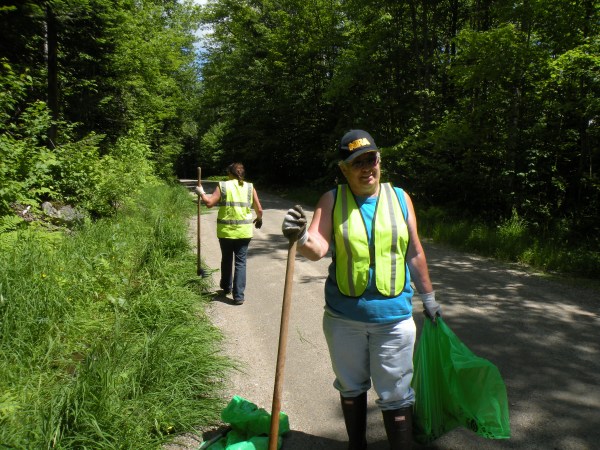
She ran the Guildhall Post Office with military precision and competence, but unstinting, even-handed fairness. She was the first in town to proudly display a Bernie Sanders sign on her lawn during the presidential primary–for many reasons, but not least because Bernie had fought so hard to protect small town post offices across New England, and because she loved his plan to assign affordable banking and check-cashing functions to those post offices. (When she put the sign up, Elvina also told me that she was “tired of the rich fat cats having their way with us.”)
In the aftermath of her death, many of us in town are feeling the loss. Yesterday, my neighbor and friend Alfred McVetty, who has known Elvina far longer than I, emailed me to say he was struggling to find the words to express how Elvina’s death affected him. “She was known by all and universally liked. For years, she carried the other postmasters and shined when she became postmistress. She never wanted to grab the limelight or brag about accomplishments. Elvina was just always there….the Town has lost a rock and a true friend.”
Rest in peace, Elvina!
-
Staycation, Late August, Essex County, Vermont
 First day of our stay-near-home vacation. We started off by harvesting from our Guildhall garden, which yielded turnips, leeks, cabbages, beans, tomatoes, cucumbers, lettuce, swiss chard, and the herbs: sage, tarragon, chives, mint, oregano, chives, parsley, fennel, dill and rosemary. I wonder how many meals this will make for us during the next ten days? Up here in the hills of Essex County, at camp, there is also a profusion of blackberries and apples, so I’m looking forward to some creative pastry-making.
First day of our stay-near-home vacation. We started off by harvesting from our Guildhall garden, which yielded turnips, leeks, cabbages, beans, tomatoes, cucumbers, lettuce, swiss chard, and the herbs: sage, tarragon, chives, mint, oregano, chives, parsley, fennel, dill and rosemary. I wonder how many meals this will make for us during the next ten days? Up here in the hills of Essex County, at camp, there is also a profusion of blackberries and apples, so I’m looking forward to some creative pastry-making.For our first vacation dinner, Edward made a delicious gazpacho, and pasta with garlic sauce. We ate our dinner overlooking the White Mountains in the distance and downed a bottle of Suavignon Blanc. Then we had some local blueberries for dessert.
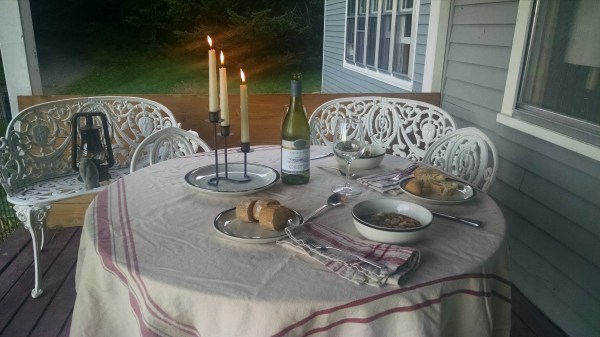
Our plan is to read, write, hike, run, bicycle, nap, garden, practice the violin, bake, do yoga, and whatever else our hearts desire. And I’m not going to check my work email even once.
-
A Birthday on Sugarloaf Mountain, Nash Stream Forest
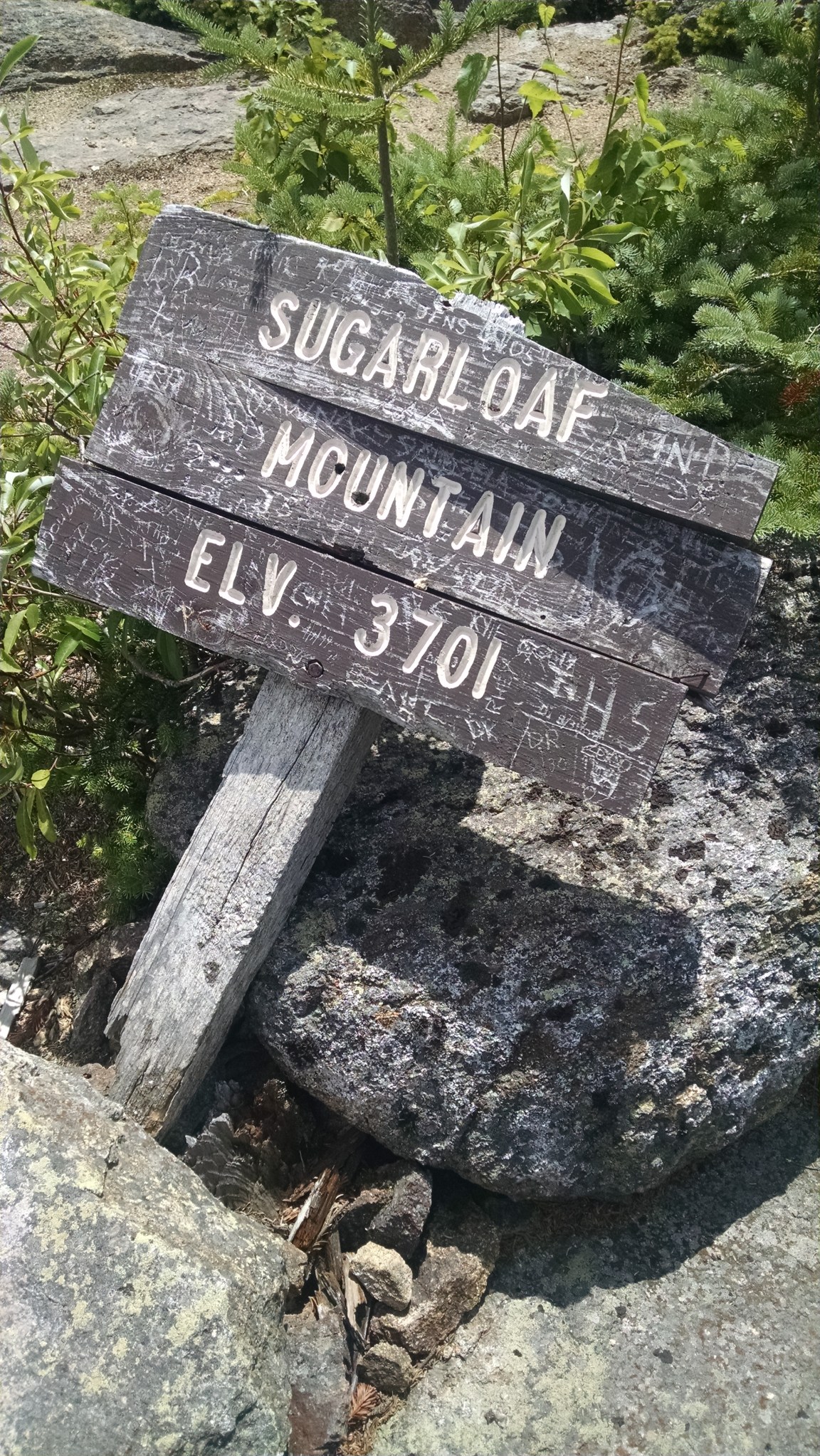 Last week, on my birthday, we decided to try a new hike, and ventured up Sugarloaf, a spectacular peak in the remote Nash Stream Forest of northern NH. In the decade since we’ve lived in the North County, we’ve traversed Nash Stream Forest on many occasions, usually to hike up North Percy Peak, a fabulous trek which ends up on a bald peak covered (in August) with sweet wild blueberries.
Last week, on my birthday, we decided to try a new hike, and ventured up Sugarloaf, a spectacular peak in the remote Nash Stream Forest of northern NH. In the decade since we’ve lived in the North County, we’ve traversed Nash Stream Forest on many occasions, usually to hike up North Percy Peak, a fabulous trek which ends up on a bald peak covered (in August) with sweet wild blueberries.Sugarloaf lies deeper into the forest primeval, and while the elevation rise is roughly the same as North Percy, the hike itself is more grueling. There are no switchbacks on the trail–it’s pretty much straight up and very steep–the very sort of trail where it becomes difficult to just put one foot in front of the other. Still, the view at the top is immensely rewarding. After a pleasant rest and some lunch, we headed down, but the downward leg of the journey is deceptive. At first, I felt relieved that I wouldn’t be continuing at the hard work of a steep upward slog. But hiking down a steep downhill can exact a painful cost on the legs. By the end, my knees and thighs were shaky and weak, and for 2-3 days, my calves ached quite badly.
That’s all for par for the course, though. It was a beautiful day. The 40,000 acre Nash Stream Forest has seemingly endless potential for exploration and I highly recommend it, because the preserve is untouched by tourism and the infrastructure conceded to hikers and others is rough and minimal. Throughout most of the 20th century, it was owned and managed by local timber interests, primarily the Groveton Paper Company. Subsequently the land was sold to Diamond International, an international paper conglomerate. Throughout the 20th century, Nash Stream Forest was a major timber resource, with logging camps and log drives down Nash Stream to the Upper Ammonoosuc and then to the Connecticut River. (Around mid-century, the river log drives were eliminated by trucking).
In 1988, a crisis loomed when Diamond International put the entire Nash Stream Forest (about 70,000 acres) on the market. Developers looked on hungrily as the price was set at $100 per acre. The danger of private subdivision and development loomed on the horizon. Fortunately, a coalition of the State of New Hampshire, the federal government, and various state environmental groups worked together–rapidly–to buy much of the acreage and preserve it as a working landscape involving regulated timber usage, recreation, (hiking, snowmobiling, fishing, hunting) and protection of wildlife habitat. (A similar process took place all over the Northern Forest as Diamond International divested its holdings in four different states, including acreage in Essex County, Vermont, where I live.)

Edward with Django, our oldest dog, who heroically climbed up with us. As you drive along Nash Stream Road, with the beautiful Nash Stream zig zagging from left to right, there’s a moonscape-like quality to the terrain that puzzled me at first. Boulders are strewn in unlikely places along the roadway and the sides of hills. The vegetation appears stunted and there are odd bare area. It wasn’t until I read up on the history of Nash Stream that I understood the reasons for this startling landscape. On May 20, 1969, the dam at Nash Bog was breached, creating what the Forest Service called a “500 year flood event.” The breach caused a 400 foot wide torrent downstream, which remains legendary in these parts. The flood gouged out the stream bed, destroyed the riparian forest on the stream banks, which had devastating consequences for the fish and wildlife of the region. The managing agency of the State of New Hampshire still considers the Nash Stream to be in recovery after the 1969 flood. Here’s a recent article describing the ongoing restoration of Nash Stream, if you’re interested!
-
What’s This Bernie Activist to Do? (Never, Ever Lose Your Sense of Outrage)
 As some of you may have noticed, I’ve neglected my blog for many months now. That’s mostly because for the first half of 2016, campaigning for Bernie Sanders consumed almost all of my spare time.
As some of you may have noticed, I’ve neglected my blog for many months now. That’s mostly because for the first half of 2016, campaigning for Bernie Sanders consumed almost all of my spare time.But in the weeks since the convention, I’ve had the chance to pause and reflect on this remarkable period in my life and in our nation’s history and to grapple with my role as a Berniecrat going forward.
Many of you among my politico friends (both Bernie and Hillary supporters) have given me some grief of late–for my persistence in blasting away at Hillary Clinton, post-convention. It’s over, many say. Move on. Accept the inevitable. And my personal favorite, which I have been told just about every day since the day Bernie launched his campaign: Grow up. (!!)
More specifically, I’m frequently told that by continuing to highlight Mrs. Clinton’s lousy positions, like her apparent fondness for war criminal types like John Negroponte and Henry Kissinger, or her continued embrace of DNC hack Debbie Wasserman Schultz, I make it more difficult for her to cruise to victory against bogeyman Trump.
Well, my friends, my insistent drumbeat of Clinton criticism isn’t sour grapes. Nor is it simply bitterness or disappointment over Bernie’s “loss–” although I concede I have those feelings in spades after busting my ass to get Bernie nominated, only to discover, in the words of Senator Harry Reid himself, that the primary “was not a fair contest.”

Verizon striker and Bernie supporter, the weekend before the NY primary, Plattsburgh No, there’s a deliberate method to my madness, and an actual strategy, crude as it might be. It’s not the strategy I would have preferred, nor is it a happy or satisfying one. I’d much rather have something positive to argue, as I did when campaigning for Bernie, a candidate with whom hope and enthusiasm blazed bright for millions like me. What’s left in the aftermath for me, and millions of others?
Will we door knock and phone canvass for Hillary? (I’ve got lots of experience with that. I’m a former union organizer and since January of this year, I have knocked on hundreds of doors in NH and NY, and made over 5,300 phone calls.) Well, no, that isn’t going to happen. As far as I can tell, even those Bernie supporters who decide to vote for Mrs. Clinton will barely manage to crawl into the voting booth, pull the lever for her, and crawl out before running off to shower themselves clean. They sure won’t be out pounding the pavement for her.
And I haven’t the slightest interest in debating who Bernie supporters should vote for in November. I have no intention of trying to convince others how to vote. We’ve got a dreadful decision to make, and each of us will have to grapple with how best to make that choice. In the meantime, we face a hideous spectacle of a general election campaign, during which few issues important to American voters will be meaningfully discussed. Instead, we will have to listen to ugly gender politics attacks and personal character assassination. My prediction is that those Americans who pay even a little attention will end up with some form of PTSD by the close of the polls on election day.
Where then to focus our efforts? How to continue the political revolution? Some will campaign on behalf of the Green Party and Jill Stein. Although it’s incredibly unlikely that Stein could win the election, there are other good reasons to go Green. Maybe, just maybe, with enough Bernie supporters flooding into the ranks of the Green party, she’ll get into the debates, onto all state ballots, and/or qualify for federal campaign funds. That would be a major, revolutionary accomplishment itself, with potential to put a crack in the two-party corporate monopoly.
Whether we choose to support Jill Stein or not, there is still much to be done. I badly wanted Clinton out of the picture, since I believe that the corporate neo-liberalism she represents has been a disaster for this country. But if stuck with her, what to do? It’s understandably tempting to give up in despair. As Chris Hedges and others have astutely pointed out, there’s been a corporate coup d’etat in this country, in which the monied interests have seized control of our democratic institutions and used them to their own benefit, at the expense of the 90% or so. That coup locked itself into place during the Obama era, and a Clinton administration will only tighten the stranglehold for years to come.

My favorite sign at the Bernie rally in Essex Junction, Vt, on Super Tuesday night, 2016. In spite of that admittedly dark outlook, however, I intend to keep fighting. And yes, Clinton is an adversary, almost as much as the GOP is. (Maureen Dowd argues in today’s New York Times that Republicans, in seeking a GOP alternative to Trump, need look no further than Mrs. Clinton herself. In other words, she’s Republican lite.) As a progressive (and a lifelong Democrat) I don’t want her the slightest bit comfortable, confident, or complacent in the belief that she can take progressives for granted, either in the run-up to the general election, or after being elected. I want her to feel cornered at every turn, to feel her feet held to the fire, and to be obsessed with worry that she’ll be a one-term president or that the left will primary her in four years. If we couldn’t have Bernie, our best chance to break the grip of the corporate fat cats over our lives, then we can apply constant pressure to the Wall Street loyalist who gets in to office instead.
My strategy is three-pronged. I will: 1) Give upgraded consideration to supporting a third party, Jill Stein of the Greens. 2) I will campaign actively, including phonebanking and door-knocking for down-ballot Berniecrats like Tim Canova, Zephyr Teachout, and my own Ed Clark here in Essex-Caledonia. 3) And I will stay laser-focused on Hillary’s every political move. I’ll call her out when she moves further and further to the right, as she surely will, in the bogus name of “pragmatism.” I’ll criticize her at the top of my lungs when she abandons any part of the Bernie-influenced platform. I’ll yell like hell when she embraces hideous hacks like Kissinger or Condi Rice.
If we’re going to slide further into the black hole of plutocracy under Mrs. Clinton’s watch, I won’t be quiet about it. None of us Bernie supporters should. I’ll protest in every way I can. That’s my strategy and I’m sticking to it. xxoo.

-
Hillary’s House (or one reason I’m voting for Bernie Sanders)
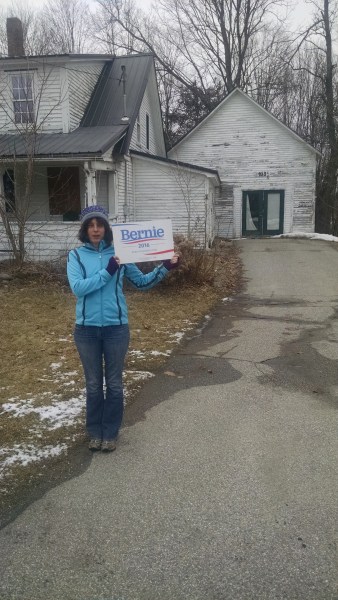
Photo by Edward Clark, Jr. Here I am with my Bernie sign, standing on the sidewalk in front of this beautiful, historic house in Guildhall, Vermont, just one lot away from my own residence.
Oh, except the house–as you can sadly see–is not so beautiful anymore. That’s because it’s been in foreclosure, sitting empty since 2009. It’s the first thing you see when you drive across the bridge from New Hampshire into our little village.
For our neighbors, a married couple who once lived here, the road to foreclosure was rapid and devastating. There was a job layoff, unemployment, low wage work, a divorce, and then, foreclosure.
The wife repeatedly begged the lender to re-negotiate the terms of the loan so that she could stay living here and caring for the house. Repeatedly, the lender refused.
Perhaps the lender preferred to sell the house, to make more money. That would make sense, I guess. But it hasn’t been sold. It has deteriorated badly, and been vandalized. I have never seen a for sale sign outside. Occasionally during summers, someone comes and mows the lawn. (Word on the street is that the lender, upon foreclosure, loaded the house heavily with insurance, let it languish and fall into disrepair, and now submits periodic claims for damage which allow them to collect big bucks).
What does this sad story have to do with Bernie? Well, actually, it has more to do with his opponent Hillary Clinton. The house went into foreclosure within a year after the now-infamous housing and foreclosure crisis of 2008. In the fall of 2008, Congress determined that the big banks and lenders were “too big to fail.” There was a long and passionate debate about whether the government should bail out the banks–in short, whether to give those banks and lenders a giant welfare check. In the end, on October 1, 2008, TARP was passed, and the banks were bailed out. Senator Bernie Sanders, who is now running for President, was the only member of our Congressional delegation to vote against that shameful bailout. He refused to support a bill that would bail out Wall St criminals, but do nothing to help regular homeowners.
Where did Hillary Clinton stand? Unlike Bernie Sanders, she supported the bailout of the lenders. But more important, as we now know, Mrs. Clinton has deep and long-standing ties to the same financial institutions which devastated our economy, and were rewarded for it with taxpayer dollars. Her ties to Goldman Sachs, Bear Stearns, and Lehman Brothers are well-known. She now refuses to come clean with the American people as to what she said in speeches for which she earned upward of $650,000.
This is why I call it the Hillary House. And this is one reason why I am voting and campaigning my heart out for Bernie Sanders.
-
Subscribe
Subscribed
Already have a WordPress.com account? Log in now.